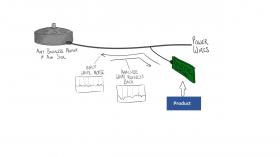Technologies Available for License
Category: electronics & instrumentation
2019-003: Reflective-Sense - Sensorless Monitoring of Motor/generator Position and Health
Invention: 2019-003
Patent Status: U.S. Patent Number 120,280,112 was issued on July 2, 2024
For technical and licensing related questions, email tcp@bnl.gov.
Summary

Physical electrical hardware that connects over pre-existing power wires and detects position or condition
Commutation of a brushless electric motor generally requires knowledge of the position of the motor's moving parts (the rotor) with respect to the fixed parts (the stator). This position feedback can be obtained either via the explicit addition of position sensing components, or by treating the rotor-stator pair itself as a sensing device. The latter category is encompassed by "sensorless" motor control, and the associated methods generally depend on the ability to measure electromotive force (EMF) back from the motor, which is calibrated as a proxy for rotor position. For back-EMF detection to be possible, the motor must be in motion, and with sufficient rapidity. Thus, sensorless control is not possible for low speed operation, such as in fine-positioning applications. The Reflective Sensing technology allows one to determine the rotor position even under low speed operation, since the technology does so without measuring the EMF back from a sensorless brushless motor.
Description
In this technology the stator windings are treated as an antenna, where each possible position of the rotor with respect to the stator represents a unique configuration of the antenna-like system due to the near-field dynamics imparted by the permanent magnets or field windings of the rotor on the stator windings. Antenna analysis techniques like measurement of Voltage Standing Wave Ratio, or equivalently, the reflection coefficient (S11 scattering parameter} is used to calibrate for rotor position. Importantly, this measurement can be conducted whether or not the motor is in motion as it has no dependence on sensing the back EMF.
Benefits
Sensorless alternative for position and condition sensing that works at zero speed, is viable in harsh environments and is retrofit friendly.
Applications and Industries
The technology can be used for electric motor position sensing or monitoring the conditions of an electric motor.
Journal Publication & Intellectual Property
- US 12,028,011 B2 (.pdf)
Tags: diagnostic
Contacts
-

Poornima Upadhya
Manager Technology Transfer & Commercialization
Technology Commercialization
(631) 344-4711, pupadhya@bnl.gov
-

Avijit Sen
IP Licensing & Commercialization
Technology Commercialization
(631) 344-3752, asen@bnl.gov




